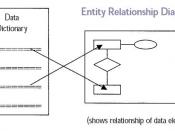DBMS is necessary to create so department managers such as purchasing, operations, marketing, and personnel may be convinced DBMS is ideal. Designing a database follows a general rule of stage analysis in:Data requirementsClassification of informationRelationship between informationTransactions among data entitiesRules of identityThere are two stages in creating a database design: data and functional model. The data model is the actual data and how it is managed. The functional model decides how data is supposed to be accessed, processed, and queried. In order to design the data model, the following steps have to be followed:â¢Identification of data objects and relationships: this is the analytical stage and data entities are given meaning through the flow of information in the system.
â¢Drafting initial Entity-Relationship diagram with entities and relationships: the relationships between various data entities are established and documented using an Entity-Relationship diagram.
â¢Refining the Entity-Relationship diagram: Entity-Relationship diagram is further refined by removing ambiguities and repetitionsâ¢Add key attributes to the diagram: from the former step, the Entity-Relationship diagram is enhanced along with incorporating key attributes of data entities (class diagrams).
â¢Adding non-key attributes: non-key attributes are extras and may also be repeated in various entities.
â¢Diagramming Generalization Hierarchies: a diagram is generalized with hierarchies in terms of security and data relativity is set.
â¢Validating the model through normalization: database is normalized to reduce discrepancies and when in motion between data entities.
â¢Adding business and integrity rules to the Model: database becomes more than a collection of data.
The process of normalization in a database is important after the Entity-Relationship diagram has been designed. "The planning and analysis stage is one part that will determine how the end system will be" (Davidson 2007). The link between data entities are simplified through normalization that helps in better design for a functional model.



Good
A good essay containing relevant information to the title. Im guessing this isnt really an essay as I find it hard to believe this amount of work would get an A in university. But it does detail what is relevant.
1 out of 1 people found this comment useful.